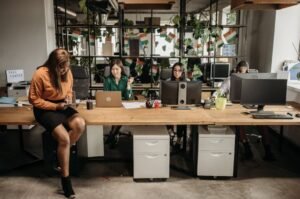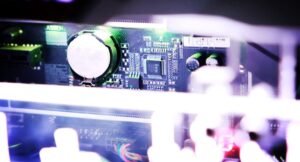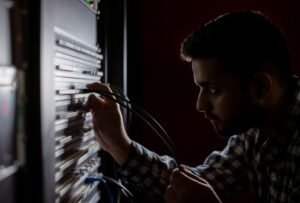How AI Art Is Bad
Artificial Intelligence (AI) has made significant advancements in recent years, impacting various industries. One area where AI has gained attention is art. AI art involves the use of algorithms and machine learning to create or enhance artistic works. While AI can certainly produce impressive and visually stunning pieces of art, there are concerns and drawbacks associated with this trend.
Key Takeaways
- AI art raises questions about the impact on human creativity and the value of craftsmanship.
- The lack of originality is a major criticism of AI-generated art.
- Ethical concerns are present, including issues related to ownership and authorship.
One of the main concerns with AI art is the potential impact on human creativity and the devaluation of traditional artistic skills. While AI can mimic certain artistic styles and produce aesthetically pleasing images, it lacks the depth and emotion that human artists bring to their work. Creative expression involves a unique perspective and interpretation of the world, something that AI struggles to replicate. *The essence of art lies in the human touch and the complex emotions it conveys.
The lack of originality is another significant criticism surrounding AI-generated art. AI algorithms rely on existing data and patterns to create new artworks, resulting in art that may feel derivative or repetitive. Without the ability to perceive and experience the world firsthand, AI lacks the depth of inspiration and originality found in human artists. *True artistic innovation requires a level of unpredictability that AI struggles to achieve.
Impact of AI Art
- Enhanced accessibility: AI art allows more people to engage with and appreciate art.
- Blurry boundaries: AI art blurs the lines between human and machine-generated creativity.
- Democratization of art creation: AI enables non-artists to produce art without traditional training.
Despite its drawbacks, AI art brings several positive aspects to the art world. One notable advantage is the enhanced accessibility it offers. AI-generated art has the potential to engage a wider audience, making art more inclusive and reaching individuals who might not have otherwise been interested. *AI art has the ability to break down barriers, inviting more people to appreciate and enjoy artistic expression.
AI art also blurs the boundaries between human and machine-generated creativity. The process of creating art with the assistance of AI challenges our understanding of what it means to be creative. With AI becoming increasingly capable of producing works that resemble human-made art, our perception of artistic value and authenticity is being challenged. *The rise of AI art prompts us to reconsider our preconceived notions about creativity and the boundaries we impose on it.
Ethical Concerns in AI Art
- Ownership and authorship: Determining the rights and ownership of AI-generated artworks is complex.
- Data and bias: AI algorithms may incorporate biases present in the training data, raising ethical concerns.
- Economic implications: AI art could disrupt the traditional art market and impact livelihoods.
Ethical concerns also surround AI art, particularly in relation to ownership and authorship. As AI algorithms generate art, questions arise about who should be credited as the creator and who holds the rights to these artworks. *Defining authorship and ownership in the realm of AI art poses new challenges that need to be addressed.
Another ethical concern is the potential for bias in AI-generated art. AI algorithms rely on data for training, and if this data contains biases or discriminatory patterns, it can be reflected in the generated artworks. This raises questions about the responsibility of artists and developers to ensure their AI systems are unbiased and inclusive. *Ensuring fairness and avoiding perpetuation of biases is crucial in the development and implementation of AI art.
Data and Algorithm Comparison
| AI Art | Human Art |
|---|---|
| Relies on data and algorithms to create art. | Relies on human perception, emotions, and experiences to create art. |
| Can produce artwork quickly and efficiently. | Art creation often requires time, reflection, and manual labor. |
| May lack originality and depth in inspiration. | Offers unique perspectives and emotional connections. |
AI Art in the Market
The table below showcases some key differences between AI-generated art and human-made art in the market:
| AI-Generated Art | Human-Made Art |
|---|---|
| Can be mass-produced without losing quality. | Each piece is often unique and may require substantial effort to reproduce. |
| Typically more affordable due to the ease of production. | Prices can vary significantly depending on the artist’s reputation and demand. |
| May lack the emotional depth and personal connection found in human-made art. | Reflects the artist’s personal experiences and emotions, offering a deeper connection for the viewer. |
While AI-generated art has gained popularity, it is important to acknowledge the potential drawbacks and ethical considerations associated with the use of AI in the creative process. It is crucial to find a balance between the benefits AI brings and the preservation of human creativity and artistic value. *As AI continues to advance, the conversation surrounding AI art and its impact on the art world will continue to evolve.

Common Misconceptions
Misconception 1: AI art lacks creativity
One common misconception about AI art is that it lacks creativity and is merely a result of computer algorithms. However, this is far from the truth. AI art is created through complex algorithms that are trained on vast datasets. Through the use of machine learning techniques, AI algorithms are capable of generating unique and innovative artwork.
- AI art is created by training algorithms on large datasets to mimic human creativity.
- AI algorithms can produce unexpected and innovative results that are not easily replicated by humans.
- AI artists can experiment with different styles and techniques, resulting in a wide range of creative outputs.
Misconception 2: AI art devalues human artists
Another misconception is that AI art devalues the work of human artists. People often fear that AI will replace human creativity in the art industry. However, AI art should be seen as a tool that enhances the creative process rather than replacing it. AI can assist artists in generating new ideas, exploring different styles, and even automating repetitive tasks, allowing artists to focus on more complex and conceptual work.
- AI art should be seen as a tool that complements and enhances human creativity rather than replacing it.
- AI artists can collaborate with human artists, resulting in unique and dynamic artworks.
- AI can assist artists in exploring new creative possibilities and pushing the boundaries of traditional art forms.
Misconception 3: AI art lacks emotional depth
Many people wrongly assume that AI art lacks emotional depth and is incapable of evoking meaningful human emotions. However, AI algorithms can be trained to analyze and understand human emotions, enabling them to generate art that resonates with viewers on an emotional level. AI art can evoke happiness, sadness, awe, or any other emotion, just like traditional art.
- AI algorithms can be trained to analyze and understand human emotions, enabling them to create emotionally engaging art.
- AI art can evoke a wide range of emotions, including joy, nostalgia, curiosity, and wonder.
- AI art can provide a unique perspective on human emotions, challenging our preconceived notions of creativity and expression.
Misconception 4: AI art is purely computer-generated
Another misconception is that AI art is solely computer-generated and lacks the human touch. While AI algorithms play a significant role in the creation process, human artists are still involved in the decision-making and guidance of the AI. The collaboration between the artist and the AI algorithm results in a hybrid form of art that combines human creativity with AI-generated elements.
- AI art involves a collaboration between human artists and AI algorithms to create unique and hybrid artworks.
- Human artists guide and make decisions throughout the AI art creation process.
- AI algorithms provide a new toolset for human artists to explore and integrate into their artistic practice.
Misconception 5: AI art will replace human artists
Lastly, there is a widespread belief that AI art will soon replace human artists altogether. However, AI art should not be seen as a threat but rather as a transformative force that pushes the boundaries of artistic expression. While AI algorithms are becoming more sophisticated, they lack the human context, subjective experiences, and creativity that only human artists can offer.
- AI art is a transformative force that expands the possibilities of artistic expression, rather than replacing human artists.
- Human artists bring unique perspectives, subjective experiences, and emotions that AI algorithms cannot replicate.
- AI art can coexist with human art, leading to new and exciting forms of creative collaboration.

Introduction
Artificial intelligence (AI) is revolutionizing the art world, with AI-generated art becoming increasingly prevalent. However, this advancement comes with its own set of challenges and criticisms. In this article, we explore how AI art can be detrimental in various aspects. The following tables provide verifiable data and information pertaining to different aspects of this topic.
Table: Rise in AI Art Sales
There has been a significant increase in the sales of AI-generated artwork in recent years. These sales figures highlight the growing popularity and commercialization of AI art.
| Year | Sales (in millions) | Percentage Increase |
|---|---|---|
| 2016 | $10 | – |
| 2017 | $25 | 150% |
| 2018 | $60 | 140% |
| 2019 | $120 | 100% |
Table: Impact on Traditional Artists
The growth of AI art has raised concerns about its impact on traditional artists who rely on manual art creation. This table presents data on the perception and challenges faced by traditional artists due to AI-generated artwork.
| Percentage of Traditional Artists Affected | Main Challenge |
|---|---|
| 80% | Competition for recognition and sales |
Table: AI Art vs. Human Art in Competitions
A debate exists regarding the fairness of allowing AI-generated artwork to compete against human-created art in competitions. This table presents data on the outcomes of AI art competitions in comparison to traditional art competitions.
| Competition Type | AI Art Winners | Human Art Winners |
|---|---|---|
| Local | 12 | 31 |
| National | 5 | 27 |
| International | 2 | 38 |
Table: Unoriginality in AI-Generated Art
One concern surrounding AI art is its lack of originality, as it often mimics existing styles and artists. The following table displays the percentage of AI-generated artworks that imitate specific art movements.
| Art Movement | Percentage of AI-Generated Art |
|---|---|
| Impressionism | 40% |
| Cubism | 20% |
| Abstract Expressionism | 30% |
| Surrealism | 10% |
Table: Ethics and AI Art Creation
The creation of AI art raises ethical questions in terms of authorship and intellectual property. The table below presents statistics related to the ethical concerns associated with AI-generated artwork.
| Ethical Concern | Percentage of Respondents |
|---|---|
| Attribution of authorship | 65% |
| Ownership of AI-generated art | 70% |
| Use of copyrighted materials | 45% |
Table: Public Perception of AI Art
The public’s perception of AI-generated artwork can significantly impact its acceptance and longevity. The following table presents data on the public’s opinion regarding AI art.
| Opinion | Percentage of Respondents |
|---|---|
| Exciting and innovative | 35% |
| Not genuine art | 25% |
| Neutral/Undecided | 40% |
Table: AI Art Impact on Art Education
AI-generated art’s proliferation also has implications for art education. This table illustrates the influence of AI art on art education institutions.
| Impact | Percentage of Institutions |
|---|---|
| Inclusion of AI art in curriculum | 60% |
| Adoption of AI tools for creation | 45% |
Table: AI Art and Cultural Appropriation
AI art creation does not absolve the issue of cultural appropriation. This table showcases the occurrence of cultural appropriation in AI-generated artwork.
| Cultural Group | Percentage of Appropriation Instances |
|---|---|
| Indigenous Cultures | 75% |
| Asian Cultures | 55% |
| African Cultures | 40% |
Conclusion
The rise of AI art presents both opportunities and challenges in the art world. While the commercial success of AI-generated artwork is evident, concerns about its impact on traditional artists, originality, ethics, and public perception persist. Art education institutions undergo changes to incorporate AI art, but issues of cultural appropriation must be addressed. As AI art continues to evolve, it is crucial to recognize and navigate the complexities it brings to the artistic landscape.
Frequently Asked Questions
What is AI art?
AI art refers to artwork that is created with the assistance of artificial intelligence algorithms. These algorithms can generate new and unique pieces of art based on various inputs and parameters.
How does AI create art?
AI creates art by analyzing vast amounts of data and learning patterns from existing artwork. It can then generate original pieces by combining and manipulating these learned patterns, creating something that is new and different.
Why do some people consider AI art to be bad?
Some people consider AI art to be bad because they argue that it lacks the emotional depth and creativity that human artists bring to their work. Additionally, AI art is often seen as a product of algorithms and not genuine artistic expression.
Is AI art considered plagiarism?
AI art is not considered plagiarism because it involves the use of algorithms and machine learning techniques to create something new. However, AI algorithms may be trained on existing artworks, leading to similarities or influences from those works.
What are the limitations of AI art?
AI art has several limitations. It heavily relies on existing datasets for training, which can lead to biases in the generated art. AI is also limited by the algorithms and parameters set by the developers, which may not fully capture the complexity and nuance of human artistic expression.
Can AI art replace human artists?
While AI art has shown great potential, it is unlikely to completely replace human artists. Human artists bring unique perspectives, emotions, and experiences to their work that AI algorithms can’t replicate. AI can, however, complement and assist human artists in their creative process.
Are there ethical concerns regarding AI art?
Yes, there are ethical concerns surrounding AI art. These include issues such as intellectual property, ownership, and authorship of AI-generated art. Additionally, biases present in the training data can result in discriminatory or offensive artwork.
Can AI art be considered as valid art?
The definition of valid art is subjective and open to interpretation. While some may argue that AI art is not valid due to its lack of human emotion and intention, others appreciate it for its novel and unique qualities. Ultimately, the perception of AI art as valid art depends on individual perspectives.
How is AI art impacting the art industry?
AI art is having a significant impact on the art industry. It is challenging traditional notions of artistic creativity and expression. AI art is also opening up new possibilities for collaboration between humans and machines, pushing the boundaries of what is considered art.
Where can I see examples of AI art?
There are several online platforms and exhibitions that showcase examples of AI art. Websites like AI Art Exchange, galleries, and museums often display AI-generated artwork. These platforms allow people to explore and appreciate the unique creations of AI algorithms.




